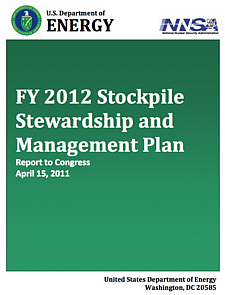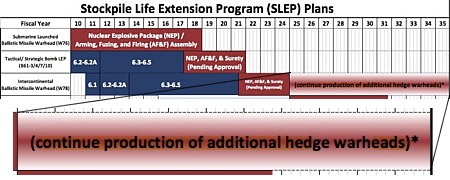 |
| Click on image to download document. |
.
By Nickolas Roth, Hans M. Kristensen and Stephen Young
Note: This is the fourth of four posts analyzing the FY 2012 Stockpile Stewardship and Management Plan, each jointly produced by the Federation of American Scientists and Union of Concerned Scientists. See previous posts: 1, 2, 3.
The FY2012 SSMP repeats the promise made in numerous previous government documents and official statements: construction of new factories with greater warhead production capability might enable retirement of some “hedge” warheads after the “responsive complex” has come online in the early-2020s and thereby reduce the overall size of the stockpile.
Today, the United States has approximately 2,150 operational warheads and another 2,850 in the hedge, for a stockpile total of 5,000. The FY2011 SSMP stated (Annex D, p. 2) that the planned production complex would be able to support a stockpile of 3,000-3,500 warheads, a level 1,500-2,000 warheads below today’s stockpile. However, it did not provide a timetable or strategy for any such reductions.
The FY2012 SSMP does, however, place conditions on further reductions. The report states that the number of nuclear weapons in the nation’s stockpile “may be reduced…if planned LEPs are completed successfully, the future infrastructure of the NNSA enterprise is achieved, and geopolitical stability permits” (emphasis added). The first two items on this list will not be accomplished for at least twenty years, but the plan shows that production of “hedge” warheads will continue even after that.
Specifically, the FY2012 SSNP states that this new production capacity is required “regardless of the size of stockpile” and shows that NNSA now plans to produce W78 hedge warheads during the 2021-2024 W78 LEP and even “continue production of additional hedge warheads” through 2035.
| NNSA Plans Production of More Hedge Warheads |
 |
| Despite a promise that construction of new warhead production facilities will permit a reduction of the “hedge” of non-deployed warheads in the stockpile, the FY2012 SSMP shows that the new facilities will be used to produce “additional hedge warheads.” The key phrase is enlarged above. Click on image to see the original. |
.
The chart hints that hedge warhead production might also be part of the other warhead LEPs in the NNSA plan. The reason for the additional W78 hedge production in 2025-2035 is not stated. Right now, there are approximately 600 W78s in the stockpile, of which 350 are in the hedge. Are they planning to increase the latter number? Or is that simply continuing production of the “common or adaptable” warhead that would be actually used in the W88 LEP later on? Have other LEPs not been performed on warheads in the hedge, but they will here? The answer is a mystery.
Yet the use of new warhead production facilities to produce additional hedge warheads undermines the administration’s message that the new facilities are needed to allow a reduction of the stockpile. It suggests that even with a new “responsive” warhead production complex, the future stockpile will still include a sizeable hedge of reserve warheads.
Additionally, although the SSMP states that these facilities are needed to “maintain a safe, secure, and reliable arsenal over the long term,” these facilities will not be operational until most of the currently planned Life Extension Programs are either completed or well underway. That makes the plan to use the new facilities to produce additional hedge warheads particularly problematic.
About the authors: Nickolas Roth is Policy Fellow for the Center for Arms Control and Non-Proliferation and a graduate student at the University of Maryland, Hans M. Kristensen is the Director of the Nuclear Information Project at the Federation of American Scientists, and Stephen Young is a Senior Analyst at Union of Concerned Scientists.
This publication was made possible by a grant from Carnegie Corporation of New York and Ploughshares Fund. The statements made and views expressed are solely the responsibility of the author.
While it is reasonable for governments to keep the most sensitive aspects of nuclear policies secret, the rights of their citizens to have access to general knowledge about these issues is equally valid so they may know about the consequences to themselves and their country.
Nearly one year after the Pentagon certified the Sentinel intercontinental ballistic missile program to continue after it incurred critical cost and schedule overruns, the new nuclear missile could once again be in trouble.
“The era of reductions in the number of nuclear weapons in the world, which had lasted since the end of the cold war, is coming to an end”
Without information, without factual information, you can’t act. You can’t relate to the world you live in. And so it’s super important for us to be able to monitor what’s happening around the world, analyze the material, and translate it into something that different audiences can understand.